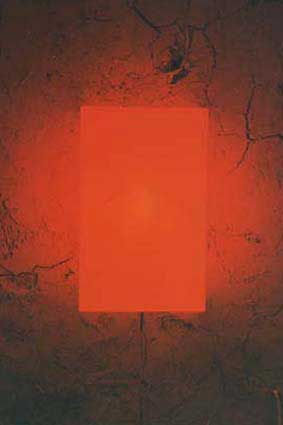home
Texts/English
link to the original page...
A s s e m b l y L a n g u a g e T o k y o A v a n t G a r d e C u l t u r e J a p a n e s e C o n t e m p o r a r y A r t
Tomoko Ninomiya and Shoji Takahara at Gallery Musunso
by Monty DiPietro
------------------------------------------------------------------------
Sometimes the biggest surprise of all can be no surprise at all. Take the current exhibition at Gallery Musunso, a strange little attic of an art space hidden down the tightest of turn-sideways-and-breathe-out-before-proceeding walkways in Tokyo's Nakano Ward. If a revolutionary spirit is percolating somewhere in the Tokyo art scene, the pipe-smoking, beret-wearing old men and greasy-haired young girls hanging around outside the gallery suggest that this is where it will be found. Climbing a rickety staircase, one can't help but anticipate from Tomoko Ninomiya and Shoji Takahara's show nothing less than an assault on the over-refined and aseptic art that so-often merely makes nice on the walls of local galleries.
But that is not the case. For although the Musunso and the people it attracts are definitely cutting edge, there is nothing angry waiting on the earthen walls of this old wooden home-cum-art space. Which is where the nice surprise comes in―the art lights the heavy room, and the two work wonderfully together in a manner neither mad nor maudlin, but rather nearly perfectly harmonized.
Ninomiya and Takahara look a lot like western artists ― he, long-haired and in leather and she in a black turtle-neck and fisherman's cap. The pair's work, however, is very Japanese ―reserved, concerned with space and spatial relationships, refined, tactile. The art here may be underground, but it does not shout, it whispers―much like the crowd of eccentrics munching daikon and sipping Bordeaux at the positively different opening party.
Gunma Prefecture-based Ninomiya, 40, works in wax and light. Each of the 21 objet she has mounted on the gallery walls consists of wire and a tangle of filament encased, along with a red LED and a battery, in a cigarette package-sized block of paraffin such that the wax glows gently from within. Based on the "Translucent Tranquilizer" series she has shown recently in Berlin and (with Takahara) in New York, the work is, in the words of the artist, "relaxing."
While Ninomiya's LEDs supply some of the light in this light-based collaborative exhibition, most of the red in the room comes from Shoji Takahara's 29 color-filtered light boxes.
"I want to change the way we see things," says Tokyo-based Takahara, 40 "even if only by one percent." The artist, who has a background in dance and design for the theater, has arranged the 28x36cm boxes, the sort used for viewing slides, on the floor and in a circle around the room-center entranceway to the gallery, where they assume an otherworldly presence and cast the room in the soft hues of orange-red that play off the walls and rafters. Much of the installation's effect can be attributed to the gallery space itself.
"The first time I walked up the stairway and saw this space," says Takahara, "I knew I wanted to show here."
Few established artists take Japan's "kashi garo," or rental-galleries, very seriously. Because there are no selection criteria, the amateur shows at pay-up-and-put-up "kashi" galleries fluctuate wildly in quality, and for many critics, covering one of these exhibitions might be put on par with the prospect of writing a concert review of a karaoke session.
But Gallery Musunso is part of a new breed of "kashi" galleries that is challenging the way we regard these institutions. Unlike their high-rent Ginza predecessors, these far cheaper spaces work less like businesses and more like collectives. Owner Tazuko Takikawa, who opened Musunso four years ago, says she is now able to mount some exhibitions for only a nominal fee or even for free.
Another reason why Musunso deserves to be regarded as a real art space is its unique atmosphere, which Ninomiya and Takahara have exploited very well with their wonderful installation of light and objet.
Surprise―there is a (quiet) revolution going on up here after all.
--------------------------------------------
Notes: Until 24 Mar, 1999 (3229-0107).
EXHIBITION:RED in BLACK//BLACK in RED
home
Texts/English



